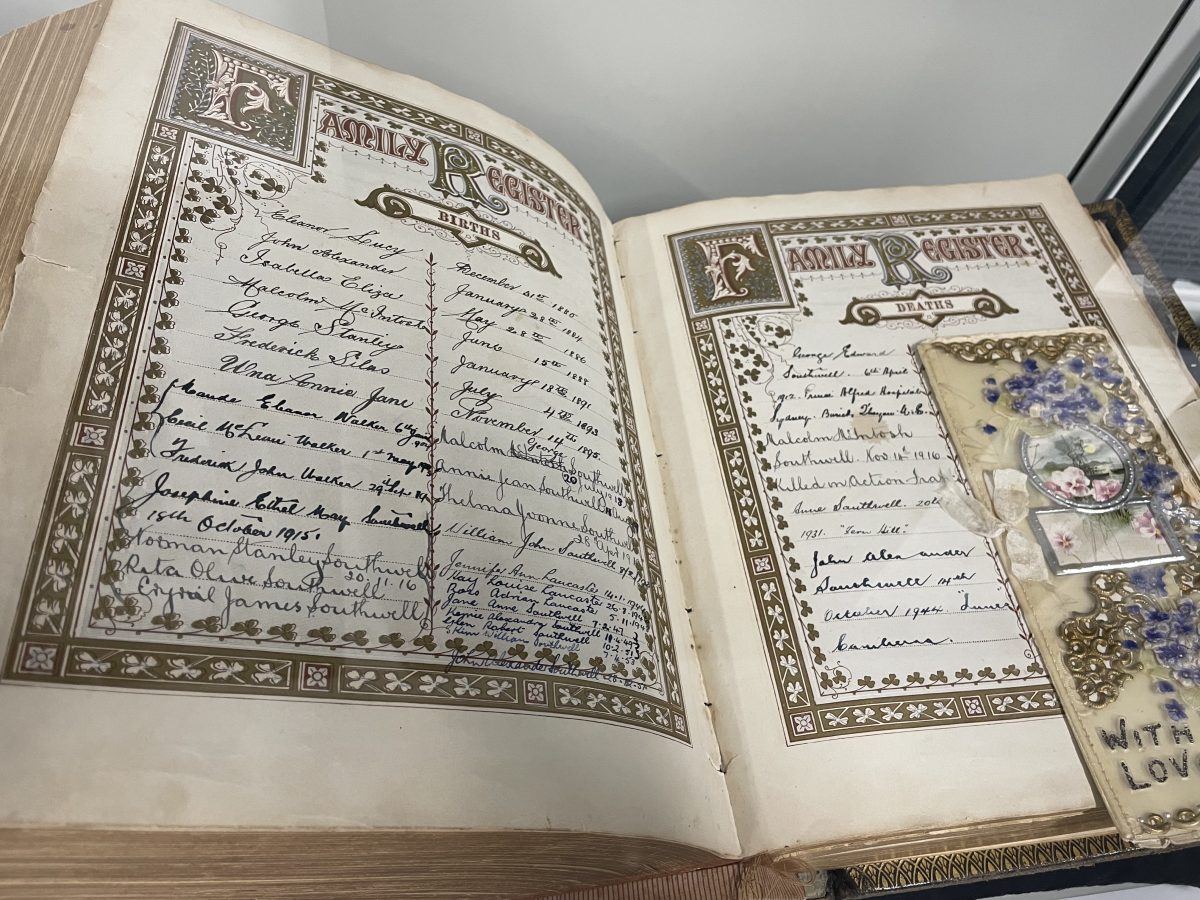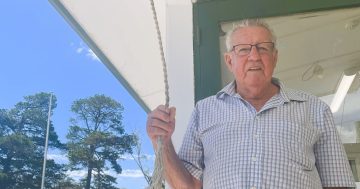
Jane Southwell with exhibition curator Peter Browning at the Hall Heritage Centre – in front of a portrait of Jane’s great, great grandfather John Southwell with his wife Lucy. Photos: Sally Hopman.
If you were organising a Southwell family reunion today, chances are you’d have to hold it outside – there are few halls that would be big enough.
One of the Canberra region’s most well-known families, the first Southwells to sail to Australia – brothers Thomas and John – took off from the struggles of early England to the unknown land on the other side of the world.
These two pioneers, originally from Sussex, settled in the Canberra district: Thomas arriving in 1840 and establishing the 987-acre property Parkwood in 1854 at Ginninderra Creek while John came in 1858, setting up Rosevale at Sutton.
When their descendants gathered at the Australian National University in Canberra in 1988 in what turned out to be the largest reunion in the family’s history, thousands of Southwells came from all over Australia to mark the 150th anniversary of their arrival in Australia – reportedly up to 6000 of them.
For Jane Southwell, great, great grandaughter of John, it’s more than just a family history worth keeping. It’s a story of how pioneers came across the world, to the most foreign of lands and how they left a mark, and continue to do so all these years later.
Primarily successful sheep farmers and wool growers, family members were to settle around Canberra, from Hall to Yass out to Sutton and further afield. They would branch out into a variety of professions, including the church, military, the law, local government and education.
With such a rich history making up the fabric of early Canberra and region, maintaining family records is paramount, Mrs Southwell said.
A “distant relative”, Peter Browning, has curated an exhibition at the Hall History Centre, called Selected Southwell Stories, about the family and its contribution to this region.
“Peter has been amazing curating this exhibition,” Mrs Southwell said. “I’m a story-teller, but he is more the expert researcher who has pulled all the stories together so beautifully.”
When the call went out about 12 months ago for items for the exhibition, Mrs Southwell said they were overwhelmed by the response.
“It was also interesting to see where some of the things had ended up,” she said.

Jane Southwell with the wedding dress she crocheted for her special day in 1973 – from “the best merino wool”. It’s one of the items now on display at the Hall Heritage Centre.
Items now on show include the Southwell family bible which Ann (McIntosh) Southwell took with her when, in the 1890s, she rode her horse between the family property Rosevale at Sutton and their mountain home at Coolamine. It is in remarkable condition and is displayed with a floral bookmark saying “with love”.
Mrs Southwell has lent a number of her special items for the exhibition, including her 1973 wedding dress. Befitting the legendary wool growing family, she crocheted it herself “from the finest undyed merino wool”.
The young Jane had learned how to crochet from the senior Jane, her grandmother, so it’s fitting that an altar cloth, crocheted by Jane Senior, is also on display. It was made especially for the centenary celebrations of the Church of St Ninian at Lyneham, also in 1973.
History fills the display cabinets with other items ranging from the mixing bowl much-used by Jane Senior who, after marrying Jack Southwell in 1917, moved to Rosevale where she milked the cows daily, using the cream and milk – in this bowl – to feed family and farm workers.

The original family bible which was also the Southwell family register, recording all major events, spent much of its life travelling with family members – on horseback.
There’s also the music box John Southwell played, an exercise book used by Jack Southwell who was later to become a teacher, and a mantle clock which belonged to Cedric Southwell, who was a councillor on Yarralumla Shire for 44 years. It was a gift on his marriage to Beryl Kilby in 1935 – and apparently still keeps perfect time.
But for Jane Southwell, one of her favourite items in the exhibition is a book called The People’s Home Library, published in 1910. It was like a bible for farmers across Australia, providing such valuable information as animal husbandry to remedies for healing most everything to a special chapter for married women titled, “Who Should Not Marry”.
Selected Southwell Stories is on display at the Hall Heritage Centre until 21 March. Open Thursdays from 9 am to midday and Sundays from midday to 4 pm. The centre is also open to groups at other times by appointment.
Original Article published by Sally Hopman on Riotact.





